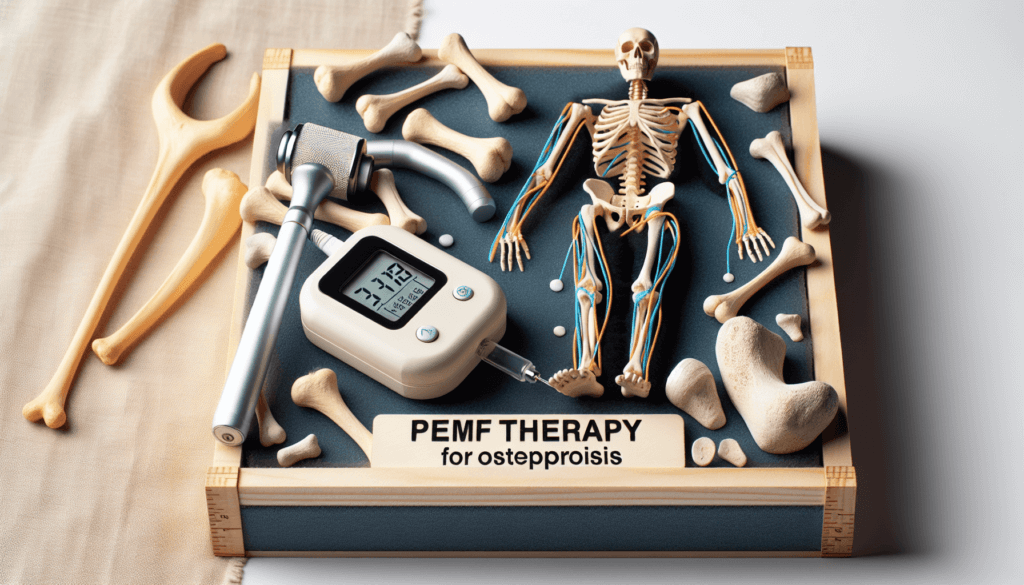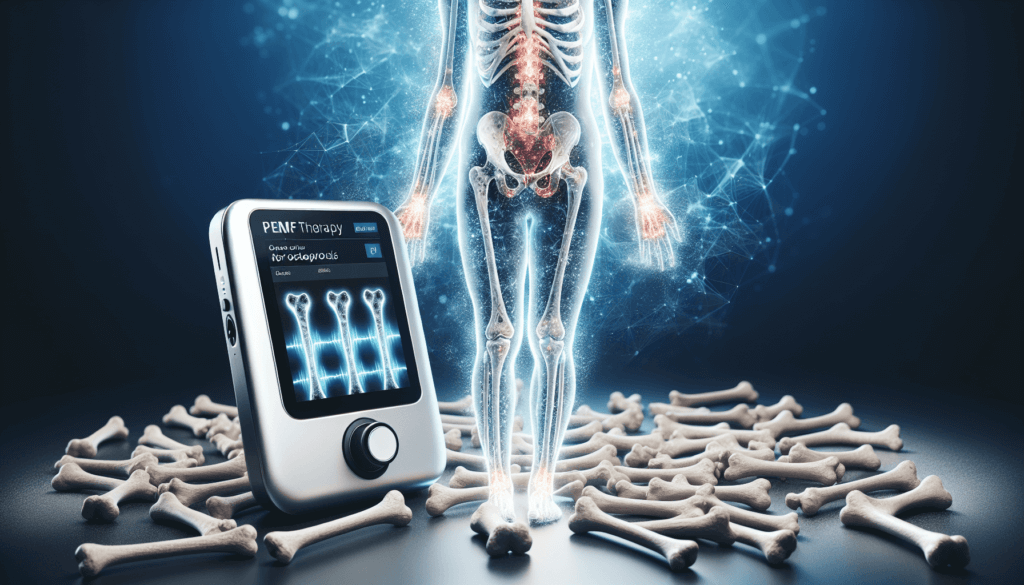Hey there! Are you tired of dealing with the painful symptoms of osteoporosis? Well, we’ve got some great news for you. In this article, we’re going to introduce you to an amazing therapy called Pemf Therapy. It’s a non-invasive treatment option that has been gaining popularity recently for its ability to relieve pain and promote healing in individuals with osteoporosis. So, if you’re ready to say goodbye to those painful days, keep reading and discover the wonders of Pemf Therapy for osteoporosis!

What is Osteoporosis?
Osteoporosis is a medical condition characterized by the loss of bone density, leading to fragile and brittle bones. It affects both men and women, but it is more common in postmenopausal women. Osteoporosis occurs when the body fails to form enough new bone or when too much old bone is reabsorbed by the body.
Definition
Osteoporosis is defined as a skeletal disorder characterized by low bone mass and microarchitectural deterioration of bone tissue, leading to increased bone fragility and susceptibility to fractures.
Causes
There are several factors that contribute to the development of osteoporosis. These include age, gender, genetics, hormonal changes (such as menopause in women), certain medical conditions (such as rheumatoid arthritis), and lifestyle choices (such as smoking and excessive alcohol consumption).
Symptoms
Osteoporosis is often called the “silent disease” because it doesn’t usually cause any symptoms until a bone fracture occurs. Common symptoms include back pain, loss of height over time, stooped posture, and easily occurring bone fractures, especially in the spine, hip, or wrist.
Conventional Treatments for Osteoporosis
There are several conventional treatments available for osteoporosis that aim to slow down bone loss, improve bone density, and prevent fractures.
Medications
Medications prescribed for osteoporosis include bisphosphonates, hormone replacement therapy (HRT), selective estrogen receptor modulators (SERMs), calcitonin, and denosumab. These medications help to inhibit bone resorption, increase bone density, and reduce the risk of fractures.
Lifestyle Changes
Making certain lifestyle changes can significantly improve the management of osteoporosis. This includes adopting a healthy diet rich in calcium and vitamin D, engaging in weight-bearing exercises, quitting smoking, limiting alcohol consumption, and ensuring a safe environment to prevent falls and fractures.
Physical Therapy
Physical therapy plays a crucial role in managing osteoporosis. It focuses on improving posture, balance, strength, and flexibility to reduce the risk of falls and fractures. Physical therapists work closely with individuals to develop customized exercise programs that are safe and effective for improving bone health.
Introduction to PEMF Therapy
PEMF therapy, or Pulsed Electromagnetic Field therapy, is a non-invasive and drug-free treatment that utilizes electromagnetic fields to stimulate the body’s natural healing processes. It has gained recognition as a potential adjunct therapy for various medical conditions, including osteoporosis.
Definition
PEMF therapy involves the use of specialized devices that emit electromagnetic waves at specific frequencies and intensities. These waves penetrate deep into the body and target the cells and tissues, promoting optimal cellular function and physiological responses.
How it Works
PEMF therapy works by generating electromagnetic fields that interact with the body’s biological processes. These fields induce electrical charges within the cells, promoting cell metabolism, enhancing blood flow, and stimulating tissue regeneration. This ultimately helps to improve bone health and prevent further bone loss.
Benefits
PEMF therapy offers several benefits for individuals with osteoporosis. It can help stimulate bone formation, increase bone density, improve bone quality, reduce pain and inflammation, and accelerate fracture healing. Additionally, PEMF therapy is non-invasive, painless, and can be performed in the comfort of your own home.
Studies on PEMF Therapy for Osteoporosis
Numerous studies have been conducted to evaluate the effectiveness of PEMF therapy for osteoporosis. Here are some key findings:
Study 1: Effects on bone density
A study published in the Journal of Bone and Mineral Metabolism found that PEMF therapy significantly increased bone mineral density in postmenopausal women with osteoporosis. The participants who received PEMF therapy showed a significant improvement in bone density compared to those in the control group.
Study 2: Effects on fracture healing
Another study published in the Journal of Orthopedic Science examined the effects of PEMF therapy on fracture healing in elderly patients with osteoporosis. The results showed that PEMF therapy significantly accelerated the healing process, reducing the time taken for fractures to unite and improving functional outcomes.
Study 3: Effects on bone formation
A study published in the Archives of Physical Medicine and Rehabilitation investigated the effects of PEMF therapy on bone formation in individuals with osteopenia. The findings showed that PEMF therapy positively influenced bone formation markers, suggesting its potential role in preventing the progression of osteoporosis.

Mechanism of PEMF Therapy for Osteoporosis
The mechanism of PEMF therapy for osteoporosis involves several key processes that contribute to improved bone health.
Stimulation of osteoblasts
PEMF therapy has been shown to stimulate the activity of osteoblasts, the cells responsible for bone formation. This leads to increased production of new bone tissue, ultimately improving bone density and strength.
Inhibition of osteoclasts
PEMF therapy also helps to inhibit the activity of osteoclasts, the cells responsible for bone resorption. By reducing bone breakdown, PEMF therapy helps to maintain bone mass and prevent further bone loss.
Enhanced calcium uptake
PEMF therapy enhances calcium uptake by bone cells, promoting optimal mineralization of the bone. This is crucial for maintaining bone density and strength, as calcium is an essential component of healthy bones.
PEMF Therapy Devices for Osteoporosis
There are various PEMF therapy devices available for the treatment of osteoporosis. These devices can be categorized into portable devices, whole-body mats, and clinical-grade machines.
Portable devices
Portable PEMF therapy devices are small, lightweight devices that can be easily used at home. They are generally designed for localized treatment, targeting specific areas of the body affected by osteoporosis.
Whole-body mats
Whole-body mats are larger PEMF therapy devices that allow for the treatment of the entire body at once. These mats are ideal for individuals with widespread osteoporosis or those looking to improve overall bone health.
Clinical-grade machines
Clinical-grade PEMF therapy machines are more powerful devices typically found in professional healthcare settings. They provide a higher intensity of PEMF therapy and can be tailored to suit individual treatment needs.
How to Use PEMF Therapy for Osteoporosis
To effectively use PEMF therapy for osteoporosis, it is important to understand the proper device settings, treatment duration, and frequency of sessions.
Device settings
Each PEMF therapy device has specific settings that determine the frequency and intensity of the electromagnetic waves. It is essential to follow the manufacturer’s instructions and consult with a healthcare professional to ensure safe and appropriate device settings.
Treatment duration
The recommended treatment duration for PEMF therapy can vary depending on the individual and the severity of osteoporosis. It is often recommended to start with shorter sessions and gradually increase the treatment duration based on personal tolerance and response.
Frequency of sessions
The frequency of PEMF therapy sessions can also vary. It is generally recommended to start with daily sessions and then transition to a maintenance schedule, which may involve two to three sessions per week. Again, consulting with a healthcare professional is crucial for determining the ideal frequency of sessions.
Safety and Precautions of PEMF Therapy
While PEMF therapy is considered safe for most individuals, there are certain safety precautions and potential side effects to be aware of.
Potential side effects
PEMF therapy is generally well-tolerated, with minimal side effects. However, some individuals may experience temporary tingling or warmth sensations during treatment. These sensations are usually mild and subside after the session.
Contraindications
PEMF therapy is not suitable for individuals with certain medical conditions or devices such as pacemakers, cochlear implants, or metal implants. Additionally, pregnant women and those with epilepsy should exercise caution or avoid PEMF therapy altogether. It is important to consult with a healthcare professional before starting PEMF therapy.
Consulting a healthcare professional
Before initiating PEMF therapy for osteoporosis, it is crucial to consult with a healthcare professional. They can provide guidance on device selection, treatment protocols, and monitor your progress throughout the therapy.
Success Stories of PEMF Therapy for Osteoporosis
Several success stories and case studies highlight the positive impact of PEMF therapy on individuals with osteoporosis.
Case study 1: Improved bone density in postmenopausal women
A case study published in the Journal of Osteoporosis documented the improvements in bone density seen in postmenopausal women with osteoporosis who underwent PEMF therapy. The study reported significant increases in bone mineral density over a period of six months, indicating the potential of PEMF therapy in promoting bone health.
Case study 2: Accelerated fracture healing in elderly patients
A case study published in the Journal of Orthopaedic Surgery and Research examined the effects of PEMF therapy on fracture healing in elderly patients with osteoporosis. The study demonstrated a significant reduction in fracture healing time and improved functional outcomes, reinforcing the potential of PEMF therapy as an adjunct treatment for osteoporotic fractures.
Case study 3: Increased bone formation in individuals with osteopenia
A case study published in Osteoporosis International investigated the effects of PEMF therapy on bone formation in individuals with osteopenia. The findings revealed a significant increase in bone formation markers after PEMF therapy, suggesting its potential to promote bone health and potentially prevent the progression of osteoporosis.
Conclusion
PEMF therapy offers a promising adjunct treatment option for individuals with osteoporosis. Studies have shown its potential to improve bone density, accelerate fracture healing, and promote bone formation. With the proper device settings, treatment duration, and frequency of sessions, PEMF therapy can be safely incorporated into the management of osteoporosis. However, it is essential to consult with a healthcare professional before starting PEMF therapy and to continue following conventional treatments and lifestyle changes to maximize the effectiveness of the overall treatment plan. Further research is needed to explore the long-term benefits and optimal protocols for integrating PEMF therapy into standard osteoporosis care.


